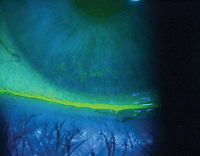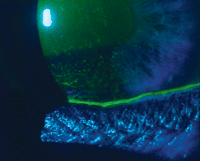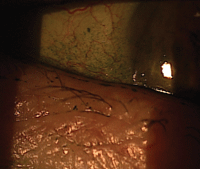When you think of a “typical” dry eye patient, who comes to mind? Perhaps a post-menopausal woman? Or a computer programmer? Or a person who suffers an autoimmune disease? True, these are the classic dry eye sufferers, but patients of every age and every stage of life can be affected by dry eye.

Dryness from incomplete blinks can happen at any age. Photos: Paul M. Karpecki, OD
At times, the clinical signs may be subtle and the symptoms little to non-existent. However, to ensure every patient’s daily comfort, remember to keep dry eye on your checklist of differential diagnoses when examining patients in any stage of life, whether young or old.
With that in mind, let’s consider dry eye in each stage of life.
Children
We don’t typically suspect dry eye in kids, but they—like patients of other ages—can suffer this daily ailment and all of its accompanying sequelae.
“A diagnosis of dry eye in children may be tricky to pick up on,” because children may not readily voice their symptoms, says Ida Chung, OD, section chief of pediatrics and associate professor at SUNY College of Optometry. “The younger the child, the less likely the child will present at an exam with a verbal complaint,” she says. So, “an effective eye exam on a child relies on a good history and objective findings.”
Take a detailed history that asks parents about specific behaviors and signs that may reveal the child is experiencing dryness, Dr. Chung says. Common symptoms of dry eye that she watches for in kids are blepharospasm, eye rubbing, tearing (or lack of tearing), photophobia, intermittent blurred vision and (rarely) burning.
The clinical signs of dry eye in children can be similar to those in adults, including “decreased tear prism, decreased tear break-up time, punctate epithelial defects that stain with fluorescein dye, and reduced visual acuity,” Dr. Chung says.
A clinical pearl just for kids: “Look carefully at the lids, because blepharokeratoconjunctivitis is an underdiagnosed condition [in children] that can result in a secondary dry eye,” she says.
Tips to Examine Kids for Dry Eye
If dry eye is so uncommon in children, what puts certain kids at risk? “Environmental factors are the most common risk factors for evaporative dry eye for the patients that I see in New York City,” Dr. Chung says. “Environmental pollutants are especially prevalent in urban areas, [and] low humidity, especially during the winter months, can put a child more at risk for dry eye.”
What else is a risk factor? The use of computers and electronic devices, as well as antihistamines taken by allergy sufferers. “Environmental factors and adverse medicine side effects usually cause mild cases of dry eyes; however, when severe dry eyes are detected (severe enough to cause significant corneal compromise), or you have a case of dry eyes that is not resolving, think something else—there may be an undiagnosed genetic or systemic condition,” Dr. Chung says. In those cases, rule out Sjögren’s syndrome, diabetes and juvenile rheumatoid arthritis.
To treat dry eye in kids, look to the parents. “Successful treatments for dry eye in kids are usually dependent on the compliance of the parents,” Dr. Chung says. She suggests using artificial tear supplements that are more viscous and require less frequent dosing, using a humidifier in the child’s bedroom, treating exacerbating conditions like allergies and meibomian gland dysfunction, as well as eliminating environmental factors whenever possible, such as better visual ergonomics when using computers and electronic devices.
Teens and 20s
Like children, patients in their teens and 20s can be overlooked when it comes to a diagnosis of dry eye, says Paul M. Karpecki, OD, of Koffler Vision Group in Lexington, Ky., who frequently lectures and writes about dry eye and eye health. This oversight could be due in part to the fact that, although a teenager may present with the same dry eye symptoms as patient at an older age, they may present with fewer clinical signs.
Environmental Factors Contributing to Dry Eye in Teens and 20-somethings
One etiology in this age group is underlying systemic disease, such as juvenile rheumatoid arthritis. This is a diagnosis that is usually made in childhood, he says, but still needs to be ruled out in teens.
Also inquire about the use of Accutane (isotretinoin, Roche), an acne medication that was taken off the market in 2009 but is still available as a generic. “What is interesting is that I’ve seen significant dry eyes in patients who were not currently on Accutane but had taken it years prior,” Dr. Karpecki says.
Another condition to look for: meibomian gland dysfunction. “I have to admit that I see a lot more MGD in younger patients than I had expected,” Dr. Karpecki says. When he sees this in teens, one of the things he asks about is their diet. He believes there is a connection between ocular surface disease and diet, in particular essential fatty acid intake. For example, people who eat more fish also tend to have less ocular surface disease, he says.
Dr. Karpecki adds that environment and habits—like not enough sleep and too much caffeine—really play a big role in teens and young adults who suffer dry eye. (See “Environmental Factors Contributing to Dry Eye in Teens and 20-somethings.")
Accordingly, treatment for teens and 20-somethings with dry eye focuses “primarily on environmental modification and behavioral changes, such as getting more sleep, but don’t avoid therapeutic treatments” that address the inflammatory component, he says. Dr. Karpecki gives patients who have taken Accutane as an example: “Many patients who have taken Accutane have significant ocular surface issues, so palliative treatments like artificial tears or environmental management won’t help the patient as much—and the signs may even get worse because they don’t address the underlying inflammation.”
When it comes to keeping an eye out for dry eye in patients who are in their 30s or 40s, listen for them to say, “My eyes feel dry when I wake up,” or “I can’t wear my contacts at the office,” or “My eyes are tearing a lot,” says Jeffrey Anshel, OD, president of the Ocular Nutrition Society and a frequent lecturer on computer vision syndrome.
“The most common sign of dry eye in patients in their 30s or 40s is lipid layer deficiency, which accelerates tear film breakup time,” he says.
| Clues for Causes of Dry Eye in 30- and 40-somethings |
Dr. Anshel points to several clues to look for related to dry eye in this age range:
|
For women in this age range, motherhood may also bring about dry eye. “If a woman in her early 30s has a newborn, lack of sleep can be a factor as well, which is also common coupled with excessive caffeine intake,” he says.
Other patients in this age group who may suffer dry eye are those who “perform hours of work on computers, which has been shown to reduce the blink rate,” he says.
Treatment of dry eye in this age group can be as varied as its causes. Among the many factors to address, “the patient should be asked about drugs and any autoimmune diseases, as well as their environmental conditions,” Dr. Anshel says.
Regarding environmental conditions, he created the “20/20/20” concept for computer users to remember to take frequent visual breaks throughout the workday. (Developed 25 years ago, Dr. Anshel’s 20/20/20 rule is: Every 20 minutes, take 20 seconds and look 20 feet away from the screen.)
He also suggests that doctors consider “blood testing to determine the level of nutrients in the body, especially the essential fatty acids, omega-3 and -6.” Recommend omega fatty acid supplements if necessary. In addition, “our bodies don’t process nutrients as efficiently as we age, so a full-spectrum multiple vitamin is usually suggested as we approach middle age,” he says.
50s and 60s
“Meibomian gland dysfunction is understood to be the leading cause of dry eye,” says Caroline Blackie, OD, PhD, senior research scientist at TearScience Inc., in Morrisville, NC. And while the age of onset for MGD has typically been understood to occur between our 40s and 60s, we now know that MGD is also highly prevalent in the younger population. “Dry eye and MGD in the 50- to 60-age range has most likely, although not always, progressed to a more chronic stage than in that of a younger patient,” she says.
Dry Eye Treatments in 50- and 60-somethings
Dry eye in patients of this age can be
further complicated by hormonal factors and systemic disease, Dr.
Blackie says. So a multi-pronged approach to treatment is frequently
necessary.
Certain factors that put that 50-plus age range at greater risk for MGD and dry eye, as compared to younger patients, include age, chronicity of disease, hormonal changes (particularly for women), polymedicine and increased systemic disease(s), Dr. Blackie says.
Additional influences—such as nutritional, environmental and behavioral factors—are more patient specific and somewhat less age specific, she says.
Treatment for dry eye in this age group tends to follow the same guidelines as for treatment of dry eye at other ages. Because MGD is obstructive in nature, treatment is directed toward removing the blockage and improving meibomian gland function. In her view, the most high-tech method is TearScience’s LipiFlow, she says.
But other approaches include manual physical expression of the glands, in-office lid margin debridement (in combination with gland expression), intraductal probing of the meibomian glands with Maskin microprobes (Rhein Medical), along with concurrent at-home therapies of lid scrubs, warm compresses and/or commercial heat packs.
If infection is suspected to be a significant contributing factor to a patient’s MGD, consider prescribing oral antibiotics because “the anti-inflammatory properties of the antibiotics have been shown to accelerate improvement in MG function,” Dr. Blackie says.
However, she emphasizes that gland evacuation is the best place to start when treating MGD and restoring the proper functioning of the glands.
70s and 80s
When patients reach these later decades of life, they are likely on multiple medications. “Dry eye can be made worse by medications patients are using for chronic conditions,” says Uyen Dao, OD, who works at Northport VA Medical Center, in Long Island, NY. “Such medicines include diuretics, anticholinergics (such as tricyclic antidepressants and antipsychotics), antihistamines, antispasmodics and antiparkinson medications—and these can worsen dry eye,” she says.
Dr. Dao also regularly performs on-site nursing home eye examinations through a private practice. “Androgen deficiency in postmenopausal women and decreased testosterone levels in older men can lead to MGD and dry eye in these patients,” she says.

Minimal tear meniscus, as seen here, indicates reduced tear film quantity, which is highly diagnostic for dry eye.
Furthermore, certain medical conditions that are more common in the elderly—including diabetes, rheumatoid arthritis, lupus, vitamin A deficiency, thyroid disorders, radiation therapy and Sjögren’s syndrome—are also known to be associated with dry eye.
In particular, patients with Sjögren’s syndrome are known to suffer from dry eyes and dry mouth caused by chronic inflammation of the mucous membranes. In the eye, this leads to improper functioning of the lacrimal gland and an overall decreased production of tears (which can be confirmed with a Schirmer’s test), Dr. Dao says. Primary Sjögren’s syndrome occurs alone (without accompanying disorders), while secondary Sjögren’s occurs in conjunction with autoimmune disorders such as lupus or rheumatoid arthritis.
Patients with Sjögren’s syndrome may go undiagnosed for years. So, if you suspect Sjögren’s, comanagement with the patient’s primary care physician or referral to a rheumatologist or immunologist is in order.
Dry eye treatments for Sjögren’s includes topical lubricants, tear-conserving strategies (such as punctal plugs), slow-release lubricant vehicles (such as Lacrisert [hydroxypropyl cellulose, Valeant]) and Restasis (cyclosporine 0.05%, Allergan).
The treatment regimen of non-Sjögren’s dry eye in patients in their 70s and 80s is similar to that of patients in other age groups; however, it may be easier for patients in a nursing home or hospital to adhere to a dosing schedule because it can be organized and administered with the help of health professionals, Dr. Dao says.
Instruct patients to use artificial tears during the day and to apply an ointment at night. Omega-3 supplements may be prescribed and a humidifier can be used during dry winter days and also during the summer when the air conditioning is running constantly and the humidity is low.

Lissamine green stain reveals devitalized cells that suggest a dry eye diagnosis.
A patient who presents with concomitant blepharitis should be treated with lid scrubs, warm compresses and antibiotic ointment.
No matter what age or stage, dry eye is a condition that can significantly affect a patient’s quality of life and interfere with daily comfort. Even when there are few to no symptoms present, if conditions that can provoke dryness are left untreated, the patient will ultimately suffer. Remember to look for the root of the problem for dry eye at any age—if one can identify and target treatment toward eliminating the underlying cause of the dry eye, it will stand a better chance of being successfully alleviated.
It is the practitioner’s job to recognize the signs and symptoms of dry eye and to provide the education and the customized treatments needed to preventatively and proactively manage this condition in each decade of our patients’ lives.

